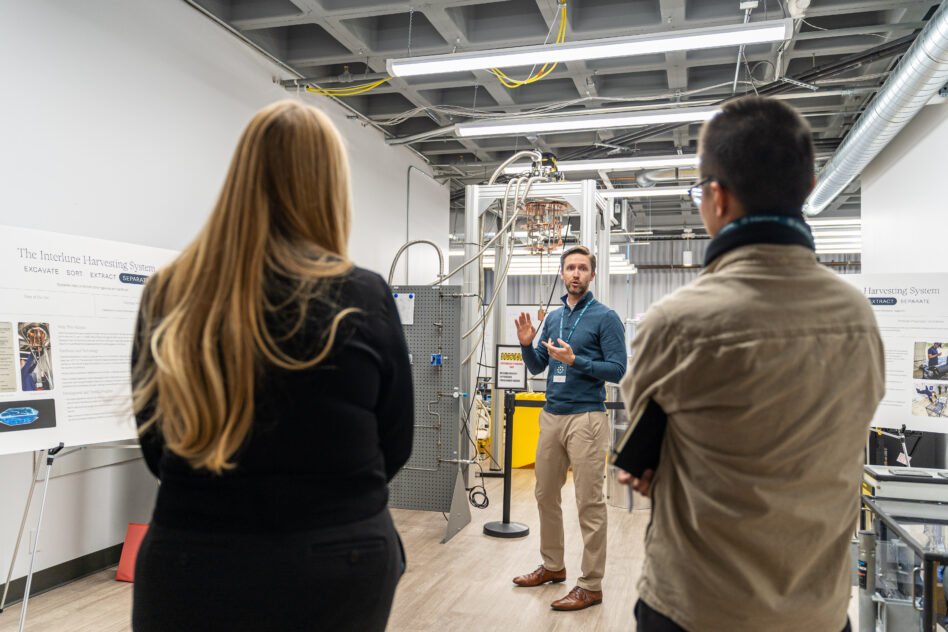If you’re a Payload reader, you’ve probably heard of Interlune. Luckily for us, the space resources startup is kicking off work a little closer to home.
On Wednesday, in an exclusive release to Tectonic, Interlune announced that they’ve scored a $1.25M AFWERX contract to increase the terrestrial supply of helium-3—a rare isotope of helium critical for cooling quantum computers—for the Air Force Research Laboratory’s (AFRL) Information Directorate.
If that makes your head spin a little, don’t worry. We’ll break it down for the more air, land, and sea-focused among us.
Mining the moon: Interlune has big ambitions. The startup—founded in 2020—is led by a roster of former Blue Origin heavyweights, including its longtime president Rob Meyerson, who want to mine helium-3 on the lunar surface, where it’s far more common than on Earth.
Hot commodity: Helium-3 (He-3) is very rare, in very high demand, and therefore very expensive. A single kilogram of the stuff sells for about $20M, according to Interlune CEO Rob Meyerson, and the US is estimated to produce only about 1 kilogram per year (around 7,500 liters).
That poses major supply-and-demand issues, especially because it’s critical to two fast-growing sectors: quantum computing and nuclear fusion energy.
- On Earth, all He-3 is a byproduct of tritium, a radioactive isotope of hydrogen that’s created in nuclear reactors with a 12-year half-life that decays to helium-3.
- Its use in fusion reactors means that the bulk of tritium is snapped up by nuclear programs unlikely to wait around 12 years for it to decay.
- The evolution of quantum computing complicates things, since He-3 is key for cooling quantum refrigerators down to near 0 Kelvin (K), or absolute zero. That freezing coldness ensures qubits stay superconducting and free from heat-induced noise and errors that would destroy their quantum states.
- While He-3 is super rare on Earth, lunar soil samples—or regolith—indicate it’s much more bountiful on the moon. That’s where Interlune comes in, at least eventually.
Still with us?
Baby steps: While Interlune ultimately aims for the moon, it’s also looking for earthside solutions in the near-term. The company is currently developing the tech on Earth before launching a prototype harvester in 2027 and eventually a lunar fleet of them to mine He-3 in the 2030s.
“We’ve created a way to extract those trace amounts of helium-3 from terrestrial natural gas supplies using a cryogenic separation process that we intend to use on the moon in the future,” Meyerson told Tectonic. “We found that we could extract that and sell that to customers as our first go-to-market here in the 2020s to start serving our quantum computing and other customers in the near term before we get to the moon.”
They’ve already inked deals with two quantum computing companies—Colorado-based Maybell Quantum and Finland-based Bluefors—for the stuff. Bluefors, which makes quantum computing refrigeration systems, placed a $300M order for up to 10,000 liters of helium-3 annually between 2028 and 2037.
Quantum crazy: The AFRL’s Information Directorate—the body in charge of the Air Force’s quantum research—is the latest customer.
Under the new $1.25M SBIR Direct-to-Phase II AFWERX contract, Interlune will prototype and demonstrate its proprietary cryogenic separation technology, which distills helium-3 from terrestrial helium without using tritium decay. The contract—Interlune’s first with the Air Force—is eligible for funding increases next year.
That prototype will be further developed at Interlune’s HQ in Seattle and used in a pilot facility before being plugged into a helium plant and scaled up for more helium-hungry customers.
“Think of it like a shipping container that would plug into a helium plant on Earth, scrub out the helium-3, leave the helium behind, and then we would sell that helium-3 to customers,” Meyerson explained (very patiently, we might add). “We’ve already demonstrated that we can enrich helium-3 from a very low concentration to 99% concentration, which gave us the confidence needed to be seen by the Air Force to award us this Direct-to-Phase II contract.”
Moonshot: Despite the short-term focus on terrestrial helium-3, the cryogenic separation process they’ll work on with the AFRL is “directly related to what we’re going to do on the moon in the future.”
“The amount of helium-3 that’s available on Earth is relatively small compared to what’s on the moon,” Meyerson said. “We expect we can double, and maybe over the long term, triple the US domestic supply of helium-3 with the terrestrial gas that we extract, whereas on the moon, we can easily 10x or 100x—or even higher—increase the annual quantities of helium-3.”
Teamwork: The growth of the commercial space ecosystem is going to be a big help in getting them up there.
“If you think about where we were in lunar exploration 10 years ago, there were no companies building systems to go to the moon,” Meyerson said. “Today, there’s more than half a dozen in the US, and another half a dozen worldwide, that are committed to going to the lunar surface, so we have many options for getting our payload to the surface today, where we didn’t just a few short years ago.”

